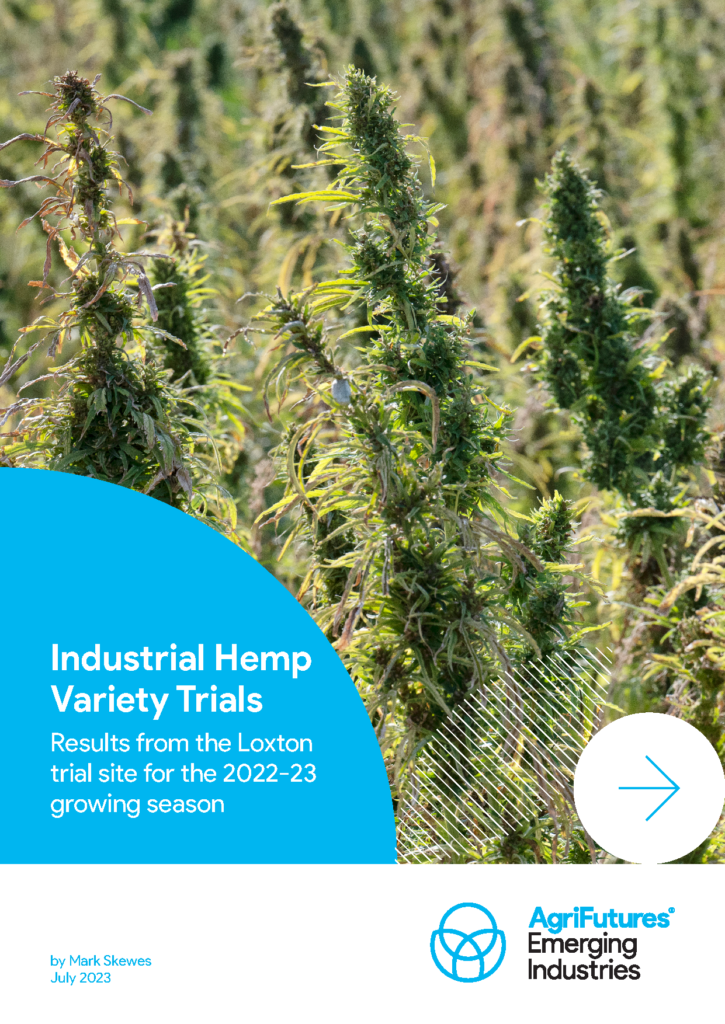AgriFutures Australia has recognised the potential for significant growth in the industrial hemp (Cannabis sativa L.) sector due to the plant’s wide range of sustainable applications and uses. The benefits associated with the oil profile of hemp grain, which has one of the best omega 3:6 ratios of any plant-based oil, is a key factor in the potential of this crop. Against this backdrop, the AgriFutures Emerging Industries Program has invested in a series of variety trials to understand the crop’s performance across Australia.
The aim of the Industrial Hemp Variety Trials (IHVT) program is to provide Australian hemp growers with essential data by evaluating grain and dual-purpose hemp varieties appropriate for different regions throughout Australia. To accomplish this, trial sites have been set up in multiple locations across Australia, encompassing the Northern Territory, South Australia (2), Tasmania, Victoria, Western Australia (2), New South Wales and Queensland.
The 2022-23 Loxton (Riverland, South Australia) trial was the second in a planned series of three trials and consisted of 10 varieties and two times of sowing (TOS), with four replicates of each treatment. TOS 1 was on 22 November 2022 and TOS 2 was on 14 December 2022. Four varieties were common between the 2021-22 and 2022-23 seasons – CFX-2, CRS-1, Henola and Katani.
In 2022-23, sowing rate aimed to account for the variable germination percentage of the trial seed. Based on previous experience, it was expected only 50% of viable seeds would result in established plants. Low seedling vigour also led to poor establishment and low plant density in some varieties.
Considering all varieties, average grain yield was less than 1.0 t/ha. Fedora 17 averaged 1.25 t/ha, with TOS 2 plantings averaging 1.48 t/ha, which is commercially acceptable. Ruby produced the lowest yield. Average grain yield across varieties was higher in TOS 2 than TOS 1. Ruby performed well and Henola performed poorly across all grain quality parameters (1,000 grain weight, bulk density, protein content, oil content). In addition, TOS 2 gave better grain quality results than TOS 1 for all parameters.
The range of values for oil content in grain from the Loxton site in 2022-23 was 7.0 to 28.8%, with an average of 17.9%. Differences between the data presented here and data from other seasons at the same site suggest seasonal conditions may have a marked influence on oil content of hemp grain. In particular, the reading for Henola in 2022-23 of 7.0% is the lowest seen at this site.
The dry matter yields, which can be equated with the production of fibre and biomass, were up to 8.5 t/ha (Ruby) and as low as 3.25 t/ha (Katani). Dry matter yields did not differ between times of sowing except for Fedora 17, which ranged from a mean of 5.5 t/ha for TOS 1 to 7.5 t/ha for TOS 2. Henola showed variable performance between the two seasons; it was the best-performing variety across a number of parameters in 2021-22 but performed poorly in 2022-23, while the other three varieties common to both seasons performed similarly across the two seasons.





